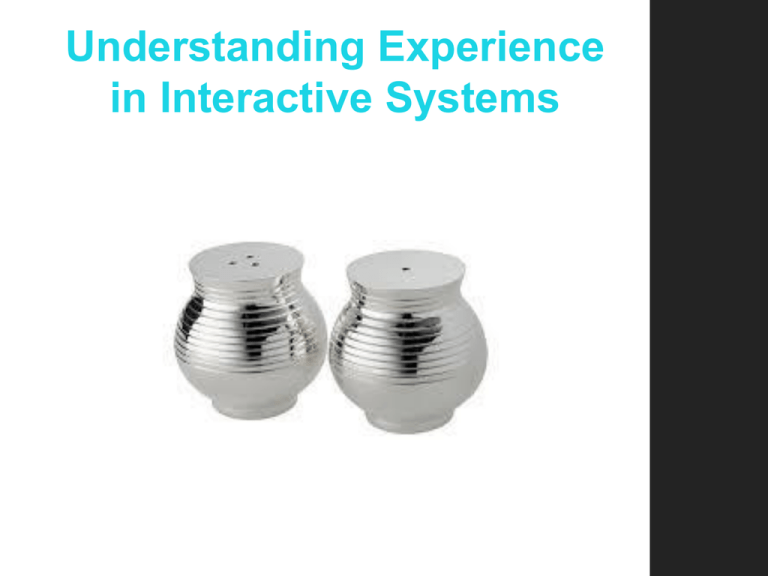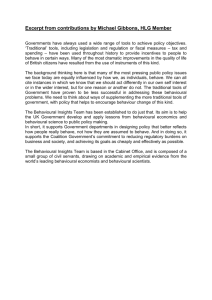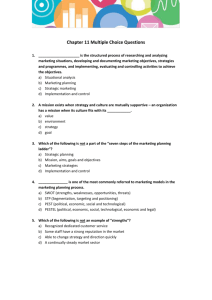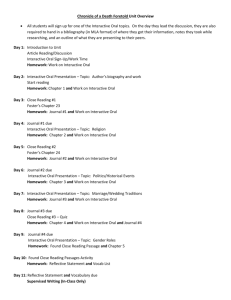Three Levels of Design
advertisement

Understanding Experience in Interactive Systems MODELS OF INTERACTION terms of interaction Norman model Some terms of interaction domain – the area of work under study e.g. graphics design goal – what you want to achieve e.g. create a solid red triangle task – how you go about doing it – ultimately in terms of operations or actions e.g. … select fill tool, click over triangle Note … traditional interaction … use of terms differs a lot especially task/goal !!! Donald Norman’s model Seven stages user establishes the goal formulates intention specifies actions at interface executes action perceives system state interprets system state evaluates system state with respect to goal Norman’s model concentrates on user’s view of the interface execution/evaluation loop goal execution evaluation system user establishes the goal formulates intention specifies actions at interface executes action perceives system state interprets system state evaluates system state with respect to goal execution/evaluation loop goal execution evaluation system user establishes the goal formulates intention specifies actions at interface executes action perceives system state interprets system state evaluates system state with respect to goal execution/evaluation loop goal execution evaluation system user establishes the goal formulates intention specifies actions at interface executes action perceives system state interprets system state evaluates system state with respect to goal execution/evaluation loop goal execution evaluation system user establishes the goal formulates intention specifies actions at interface executes action perceives system state interprets system state evaluates system state with respect to goal Using Norman’s model Some systems are harder to use than others Gulf of Execution user’s formulation of actions ≠ actions allowed by the system Gulf of Evaluation user’s expectation of changed system state ≠ actual presentation of this state Human error - slips and mistakes slip understand system and goal correct formulation of action incorrect action mistake may not even have right goal! Fixing things? slip – better interface design mistake – better understanding of system INTERACTION STYLE dialogue … computer and user distinct styles of interaction Common interaction styles command line interface menus natural language question/answer and query dialogue form-fills and spreadsheets WIMP point and click three–dimensional interfaces Command line interface Way of expressing instructions to the computer directly function keys, single characters, short abbreviations, whole words, or a combination suitable for repetitive tasks better for expert users than novices offers direct access to system functionality command names/abbreviations should be meaningful! Typical example: the Unix system Menus Set of options displayed on the screen Options visible less recall - easier to use rely on recognition so names should be meaningful Selection by: numbers, letters, arrow keys, mouse combination (e.g. mouse plus accelerators) Often options hierarchically grouped sensible grouping is needed Restricted form of full WIMP system Natural language Familiar to user speech recognition or typed natural language Problems vague ambiguous hard to do well! Solutions try to understand a subset pick on key words Query interfaces Question/answer interfaces user led through interaction via series of questions suitable for novice users but restricted functionality often used in information systems Query languages (e.g. SQL) used to retrieve information from database requires understanding of database structure and language syntax, hence requires some expertise Form-fills Primarily for data entry or data retrieval Screen like paper form. Data put in relevant place Requires good design obvious correction facilities Spreadsheets first spreadsheet VISICALC, followed by Lotus 1-2-3 MS Excel most common today sophisticated variation of form-filling. grid of cells contain a value or a formula formula can involve values of other cells e.g. sum of all cells in this column user can enter and alter data spreadsheet maintains consistency WIMP Interface Windows Icons Menus Pointers … or windows, icons, mice, and pull-down menus! default style for majority of interactive computer systems, especially PCs and desktop machines Point and click interfaces used in .. multimedia web browsers hypertext just click something! icons, text links or location on map minimal typing Three dimensional interfaces virtual reality ‘ordinary’ window systems highlighting visual affordance indiscriminate use just confusing! 3D workspaces flat buttons … click me! use for extra virtual space light and occlusion give depth distance effects … or sculptured THREE LEVELS OF DESIGN visceral | behavioural | reflective THREE LEVELS of design visceral | behavioural | reflective Play part in shaping one’s experience Important Require a different approach by the designer VISCERAL DESIGN visceral | behavioural | reflective QUOTE visceral design “ Package designers and brand managers are looking beyond graphic elements or even the design as a whole to forge an emotional link between consumers and brands ” The entire success of a product PACKAGE, not content BOTTLE OF WATER VISCERAL DESIGN what? Is what nature does Powerful emotional signals from the environment are automatically interpreted at this level Culturally Perception of “pretty” Visceral design is all about emotional impact DOMINATING FACTORS LOOK FEEL SOUND DOMINATING FACTORS Physical features LOOK FEEL SOUND These principles are wired in, consistent across people and cultures VISCERAL DESIGN where? Advertising Folk Crafts Children items VISCERAL DESIGN: how? About initial reactions Studied Putting people in front of a design Waiting for reactions What is the reaction the visceral designer strives for? I want it What does it do? How much does it cost? BEHAVIOURAL DESIGN visceral | behavioural | reflective BEHAVIOURAL DESIGN “Use and performance” Four components 1. Function 2. Understandability 3. Usability 4. Physical feel BEHAVIOURAL DESIGN FUNCTION FUNCTION Comes first Product To fulfil needs Tricky TRICKY Question: what does a product do, what function does it perform? Answer: it has to fulfil needs Difficult: why ? People’s needs are not as obvious as might be thought Importance for designers Designers have to watch their customers to understand how they will use a product PRODUCT DEVELOPMENT Enhancement = making an existing product or service better Easiest: comes primarily by watching how people use what exists today Innovation = completely new way of doing something that was not possible before Difficult to access: cannot be evaluated by asking potential customers for their views CAR CUPHOLDERS BEHAVIOURAL DESIGN UNDERSTANDING UNDERSTANDING The secret = to establish a proper conceptual model Three mental images 1. Designer’s model 2. User’s model 3. System image = conveyed by the product and written material (advertising and manuals) The system image of the final design conveys the proper user model FEEDBACK “Component of understanding” To give continual feedback Computer Amazing: many products give inadequate feedback To be effective? Enhance the conceptual model Indicating precisely What is happening and what remains to be done? BEHAVIOURAL DESIGN USABILITY USABILITY Complex topic “a product that does what is required and is understandable, may still not be usable” E.g. guitars, violins, piano Usage = the critical test of a product: How well does the product perform? How comfortable does it feel to use? Challenge = UNIVERSAL DESIGN BEHAVIOURAL DESIGN PHYSICAL FEEL PHYSICAL FEEL matters Designers worry a lot about the physical feel of their products Make huge difference in our appreciations They are critical to our behavioural assessment of a product Physical feel matters: why? We are biological creatures: interaction between our sensory systems and the environment + BEHAVIOURAL DESIGN + Human-centered Understanding and satisfying the needs Observation Visceral and behavioural reactions are subconscious Make us unaware of our true reactions and their causes REFLECTIVE DESIGN visceral | behavioural | reflective REFLECTIVE DESIGN what? Message, culture, meaning of a product The image we present to others The essence of reflective design: it’s all in the mind of the beholder QUESTION function vs fashion ATTRACTIVENESS <> BEAUTY Attractiveness Visceral level The response is entirely to the surface look of an object Beauty Reflective level It is influenced by knowledge, learning and culture Advertising can work at either the visceral or the reflective level REFLECTIVE LEVEL product Shows person’s overall impression Customer relationships play a major role A good relationship reverse a negative experience Is about long-term customer experience Service Providing a personal touch Warm interaction CONCLUSION A human-centered approach works well for behavioural design, but it is not necessarily appropriate for either the visceral or the reflective side Conclusion If you want a successful product, test and revise If you want a product that can change the world: let it be driven by someone with a clear vision






